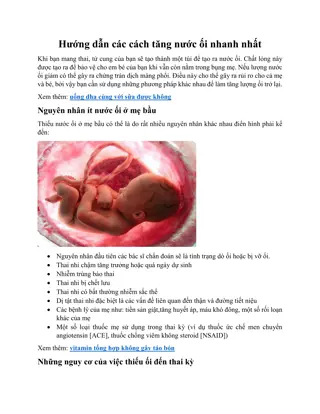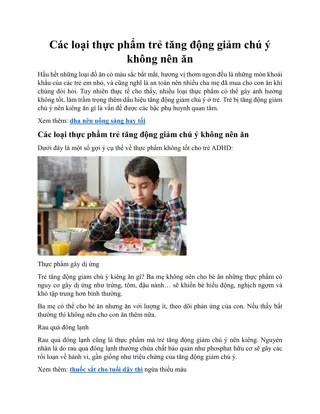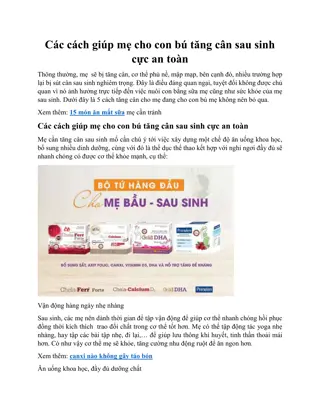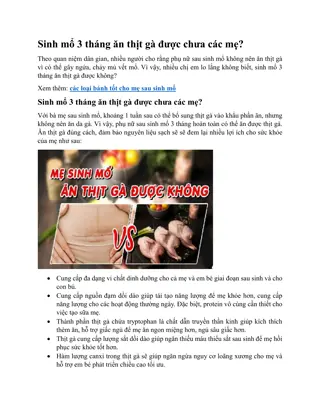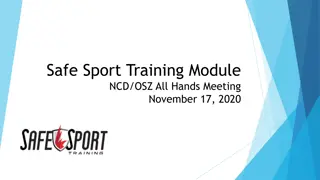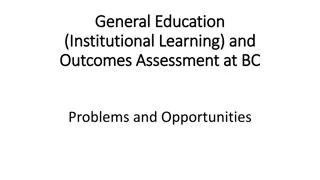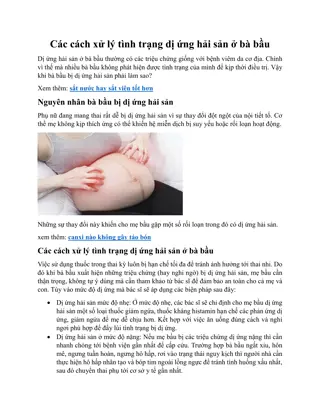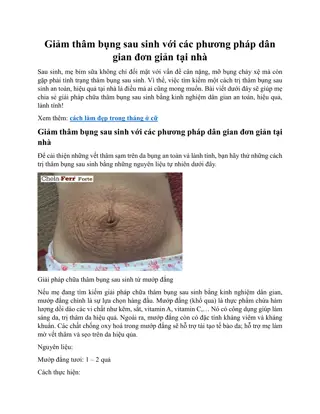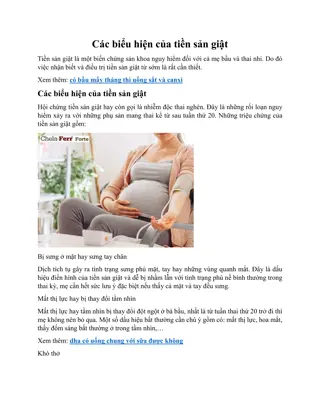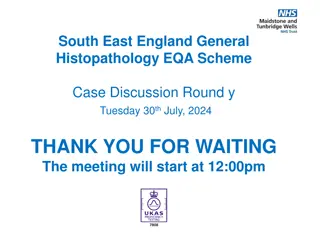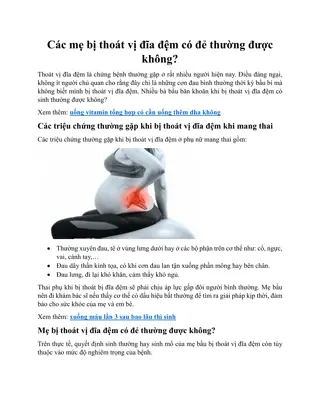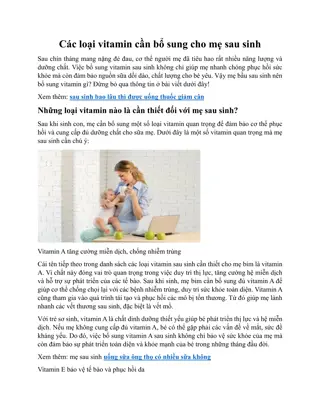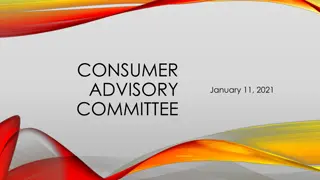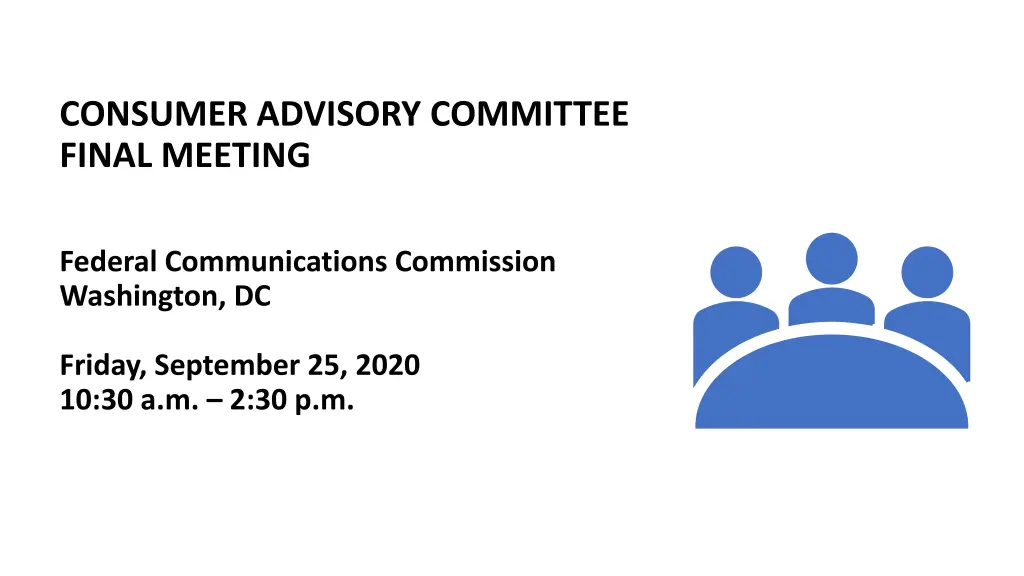
FCC Consumer Advisory Committee Final Meeting Highlights
Learn about the key discussions and presentations from the Federal Communications Commission's Consumer Advisory Committee final meeting, including addressing COVID-19 challenges and FCC staff updates. Topics covered include accessibility during the pandemic and waivers granted to ensure continued TRS service. Stay informed about the latest initiatives and responsibilities undertaken by the FCC to serve consumers effectively.
Uploaded on | 1 Views
Download Presentation

Please find below an Image/Link to download the presentation.
The content on the website is provided AS IS for your information and personal use only. It may not be sold, licensed, or shared on other websites without obtaining consent from the author. If you encounter any issues during the download, it is possible that the publisher has removed the file from their server.
You are allowed to download the files provided on this website for personal or commercial use, subject to the condition that they are used lawfully. All files are the property of their respective owners.
The content on the website is provided AS IS for your information and personal use only. It may not be sold, licensed, or shared on other websites without obtaining consent from the author.
E N D
Presentation Transcript
CONSUMER ADVISORY COMMITTEE FINAL MEETING Federal Communications Commission Washington, DC Friday, September 25, 2020 10:30 a.m. 2:30 p.m.
10:30 AM INTRODUCTION AND AGENDA Steve Pociask, CAC Chairperson Debra Berlyn, CAC Vice Chairperson
10:40 AM ROLL CALL Steve Pociask, CAC Chairperson Debra Berlyn, CAC Vice Chairman
10:50 AM WELCOME AND OVERVIEW Ajit Pai, Chairman, FCC Brendan Car, Commissioner, FCC
11:15 AM PANEL A: ADDRESSING COVID-19 CHALLENGES Accessibility During the Pandemic oDiane Burstein, Deputy Chief, CGB COVID-19 Scam Alerts and Updated Consumer Guides oEd Bartholme, Associate Chief, CGB Update on Telehealth Initiatives oHayley Steffen, Attorney-Advisor, Telecommunications Access Policy Division, WCB
Accessibility During the Pandemic Diane Burstein Deputy Bureau Chief Consumer and Governmental Affairs Bureau Federal Communications Commission
Waivers to Ensure Continued TRS Service Providers expressed significant concerns about the impact of the coronavirus on telecommunications relay services (TRS) Increase in call volume Decrease in ability to handle calls from call centers Potential shortage of qualified personnel due to coronavirus FCC granted several waivers to provide more flexibility, starting in March Most recently, extended previously granted waivers until November 30, 2020
Reminders to Video Providers about Accessible Emergency Information TV stations and other video providers must make emergency information about the pandemic accessible to people with disabilities Critical details about emergencies must be presented visually and aurally Best practice is to ensure that the sign language interpreter is visible on the television screen at all times in order to benefit viewers who use American Sign Language
Letter Urging Governors to Assist Communications Industry During Pandemic On May 26, 2020, FCC and the Cybersecurity and Infrastructure Security Agency released a joint letter to the nation s governors and D.C. mayor. With regard to accessibility, the letter asked the governors to declare the following as essential and to ensure they have appropriate resources and access: Businesses and personnel that provide communications support to medical and healthcare facilities, assisted care and living facilities, and people with disabilities, and TRS providers and closed captioning providers.
Uninterrupted Consumer Services Consumers can still reach the FCC to obtain assistance and information and to file complaints by phone and email or online at www.fcc.gov/complaints ASL users may call the FCC directly by videophone 844-432-2275 Contact the Disability Rights Office for more information at: DRO@fcc.gov 202-418-2517 www.fcc.gov/accessibility
COVID-19 Scam Alerts and Updated Consumer Guides Ed Bartholme Associate Bureau Chief Consumer and Governmental Affairs Bureau Federal Communications Commission
COVID-19 Scams Web Page
Sanitize Your Phone Infographic
Back to School Poster
Update on Telehealth Initiatives COVID-19 Telehealth Program Connected Care Pilot Program Hayley Steffen Attorney Advisor Wireline Competition Bureau Telecommunications Access Policy Division
COVID-19 Telehealth Program Overview Connected Care Pilot Program (Upcoming)
COVID-19 Telehealth Program Congressionally appropriated budget of $200 million to help eligible health care providers maximize their provision of connected care services during the COVID-19 pandemic. CARES Act, Pub. L. No 116-136, 134 Stat. 281 (2020) Report & Order, FCC 20-44 (April 2, 2020) Funding Awards 539 funding applications in 47 states plus Washington, D.C. and Guam for a total of $200 million in funding. For more information: https://www.fcc.gov/covid-19-telehealth-program
Connected Care Pilot Program Established - Report & Order, FCC 20-44 (April 2, 2020) 47 U.S.C. 254(h) What is the Pilot Program? A limited duration program that will make available up to $100 million of universal service support over a three-year funding period to help defray health care providers qualifying costs of providing connected care services, particularly to low-income Americans and veterans.
Connected Care Pilot Program Who can apply? Public and Non-Profit Eligible Health Care Providers that fall into one of the categories in 47 U.S.C. 254(h)(7)(B) Determine whether you are eligible by filing an FCC Form 460 with USAC. What services are eligible? 85% of the qualifying costs of: (1) patient broadband Internet access services, (2) health care provider broadband data connections, (3) other connected care information services, and (4) certain network equipment. The Pilot Program will not fund end-user devices or medical equipment.
Connected Care Pilot Program Where can I find the application? The application is not yet available, and the Commission has not announced when the application filing window will open. A Public Notice with details about the application requirements was recently released (DA-1019) and can help to prepare interested applicants for the application becoming available. Where can I find updates about the Connected Care Pilot Program? The FCC s Connected Care webpage: https://www.fcc.gov/connectedcarepilot
For more information and Frequently Asked Questions (FAQs) about the Connected Care Pilot Program, please visit https://www.fcc.gov/connectedcarepilot. Questions? For questions about the Connected Care Pilot Program, please email ConnCarePltProg@fcc.gov.
11:40 PM PANEL B: COMBATTING ROBOCALLS Call Blocking Report and Order oJerusha Burnett, Attorney-Advisor, Consumer Policy Division, CGB Call Blocking Tools Report oMika Savir, Attorney-Advisor, Consumer Policy Division, CGB Hospital Robocalls Protection Group oDonna Cyrus, Designated Federal Officer, HRPG, CGB
HOSPITAL ROBOCALL PROTECTION GROUP Donna Cyrus, DFO September 2020
On June 25, 2020, the Commission established the Hospital Robocall Protection Group (HRPG), a new federal advisory committee dedicated to combatting robocalls to hospitals. Congress directed the FCC to establish the HRPG in the Telephone Robocall Abuse Criminal Enforcement and Deterrence Act of 2019 (TRACED Act). The HRPG also is organized under, and operates in accordance with, the FACA. The TRACED Act requires that the HRPG produce hospital robocall mitigation recommendations no later than the week of December 21, 2020. OVERVIEW OVERVIEW
In accordance with the TRACED Act, the HRPG will issue best practices regarding the following: How voice service providers can better combat unlawful robocalls made to hospitals How hospitals can better protect themselves from such calls, including by using unlawful robocall mitigation techniques How the Federal Government and State governments can help combat such calls OVERVIEW OVERVIEW (CONT D) (CONT D)
HRPGs initial meeting was on July 27, 2020. Since then, its three working groups have been actively meeting and working to produce the required recommendations. The Traced Act also requires that the Commission complete a proceeding no later than June 2021 to assess the extent to which the voluntary adoption of the best practices can be facilitated to protect hospitals and other institutions. OVERVIEW OVERVIEW (CONT D) (CONT D)
Follow HRPG at: https://www.fcc.gov/hospital- robocall-protection-group WEBSITE? WEBSITE?
12:05 PM LUNCH BREAK (35 MINUTES)
12:40 PM PANEL C: ADVANCING EMERGENCY RESPONSE CAPABILITIES PSAPs Real-Time Text Capacity o Suzy Singleton, Chief, Disability Rights Office, CGB National Suicide and Mental Health Lifeline o Jesse Goodwin, Attorney-Advisor, Competition Policy Division, WCB
911 Call Centers and Real-Time Text Technology Consumer Advisory Committee September 25, 2020 Suzy Rosen Singleton, Chief, Disability Rights Office, CGB Federal Communications Commission
TTY RTT Transition Necessary for Modernized Times TTY technology was developed for use on the PSTN FCC rules requiring TTY support TTYs do not work well in an IP environment: packet loss, distortion, transmission errors can degrade quality of communications TTY usage is rapidly declining, especially for wireless services Real-Time Text (RTT) recognized as superior accessibility solution for IP networks Fully integrated with mainstream voice communications (simultaneous voice and text) Can be used with off-the-shelf devices Uses Unicode character set (allows symbols, languages)
Modernizing Communications: FCC Report and Order and Further Notice of Proposed Rulemaking on Real-Time Text December 2016: FCC adopted rules to facilitate the transition from TTYs to RTT over wireless Internet Protocol (IP) technologies. New rules permit the support of RTT in lieu of supporting TTY technology. Covered entities that support RTT in compliance with the FCC s rules will be relieved of TTY support requirements on all wireless networks and equipment, including services and devices used for legacy non-IP facilities. Covered entities: IP-based wireless providers. Manufacturers of end user equipment.
Required RTT Core Functionalities Interoperable across networks and services (RFC 4103 standard is used as the safe harbor standard) Backward compatible with TTYs Support for 911 communications Simultaneous text and voice in the same call session Ability to initiate and receive call with the same telephone number
Compliance Timelines Service Providers. By December 31, 2017, each Tier I CMRS provider and, by June 30, 2020, each non-Tier I provider (except resellers) choosing to support RTT shall support RTT either: (1) through a downloadable RTT application or plug-in that supports RTT; or (2) by implementing native RTT functionality into its core network, offering at least one handset model that supports RTT, and including support for RTT in future design specifications. By December 31, 2019, each Tier I CMRS provider and, by June 30, 2021, each non-Tier I CMRS provider (including resellers) choosing to support RTT shall support RTT for all new authorized user devices. Manufacturers. Covered manufacturers that choose to support RTT, instead of TTYs, shall implement RTT in newly manufactured equipment by December 31, 2018, if readily achievable or unless not achievable.
PSAP Readiness for RTT FCC requires that carriers deliver text messages to PSAPs that are text-enabled within six months of a PSAP s request. The FCC maintains a text-to-911 registry, and RTT will be included once OMB approves the updated form. The comment period closed in early September 2020 with no opposition filed. The registry is found at www.fcc.gov/text-to-911. The FCC hosted a PSAP RTT Awareness Day in October 2018, and resources are available at www.fcc.gov/rtt. On August 3, 2020, NENA published draft NENA PSAP Readiness for Real-Time-Text Information Document with guidelines for installation and use of RTT. The comment period closed September 11, 2020. Case study: CA s 438 PSAPs and Cal. Gov. Code Section 53112: by January 1, 2021, each CA PSAP shall be RTT and SMS-enabled.
Resources Subscribe to AccessInfo@fcc.gov Visit FCC Disability Rights Office webpage: http://www.fcc.gov/accessibility FCC s webpage about RTT https://www.fcc.gov/rtt Contact FCC DRO at: DRO@fcc.gov (e-mail) 844-432-2275 (VideoPhone) 202-418-2517 (Voice) Online Complaint Form: www.fcc.gov/complaints
Consumer Advisory Committee 988 National Suicide Hotline Overview Jesse Goodwin Attorney Advisor Federal Communications Commission Wireline Competition Bureau Competition Policy Division September 25, 2020
Overview The FCC has designated 988 for the National Suicide Prevention Lifeline, to be available July 16, 2022. 988 is not active yet. If you want to call the National Suicide Prevention Lifeline, call 1-800-273-TALK. This presentation will cover: - 988 s background; - the Notice of Proposed Rulemaking; - the Order; and - Next steps 39
2018 Act and Report On August 14, 2018, Congress passed the National Suicide Hotline Improvement Act of 2018, which tasked the FCC with examining and reporting on the technical feasibility of designating a shorter number a simple, easy-to- remember, 3-digit dialing code for a national suicide prevention and mental health crisis hotline. One year later, FCC staff, in consultation with the North American Numbering Council, Substance Abuse and Mental Health Services Administration, and Department of Veterans Affairs, released a report recommending the FCC initiate a rulemaking to adopt 988 as a single-purpose 3-digit code for the National Suicide Prevention Lifeline. 40 40
Why 988? A unique 3-digit code obviates the need to age an existing N11 code and should reduce the overall implementation timeline. A wholly unique 3-digit code would be less disruptive to existing users. Consumer education campaigns for a unique 3-digit code would be simpler and likely more effective than those necessary for repurposing or expanding use of an existing N11 code. 988 is less technically complicated than using other unique 3-digit dialing codes. 41 41
Rulemaking Proceeding On December 16, 2019, the FCC released aNotice of Proposed Rulemaking that proposed to designate 988 as the 3-digit dialing code for the National Suicide Prevention Lifeline We received a robust record of comments from the mental health community, telecommunications companies, and other interested parties On July 16, 2020, the FCC adopted a Report and Order that adopted 988 as the 3-digit code for the Lifeline and required providers to implement 988 within two years. 42
Timeline and Implementation The Order requires all telecommunications carriers, interconnected voice over Internet Protocol (VoIP) providers, and one-way VoIP providers to make any network changes necessary to ensure that users can dial 988 to reach the Lifeline by July 16, 2022. Providers will route calls to 988 to the existing toll free access number (1-800-273-8255 / 1-800-273-TALK). Requires covered providers to implement 10-digit dialing in areas that both use 7-digit dialing and 988 as the first three digits of a number. North American Numbering Plan Administrator currently working with providers toward implementation. 43
Non-Voice Communication Several ways to get help: - Several text messaging options for suicide prevention are available nationwide, including a short-code to reach the Veterans Crisis Line (838255) and the non- profit Crisis Text Line (741741). - Lifeline offers online chat - Lifeline maintains a separate TTY number - The FCC did not mandate text messaging or direct video calling to 988 because it does not control the features of the Lifeline. 44
Questions/Contacts/Links Jesse Goodwin Federal Communications Commission Attorney Advisor 202.418.0958 Benjamin.Goodwin@fcc.gov Links: National Suicide Hotline Improvement Act of 2018, https://www.congress.gov/115/plaws/publ233/PLAW-115publ233.pdf NANC Report https://www.fcc.gov/ecfs/filing/10531153709624 FCC Report to Congress https://docs.fcc.gov/public/attachments/DOC-359095A1.pdf Order https://docs.fcc.gov/public/attachments/FCC-20-100A1_Rcd.pdf 45 45
1:00 PM PANEL D: PROMOTING 21ST CENTURY TECHNOLOGIES AND SERVICES Spectrum and Infrastructure Policies to Accelerate Access to Spectrum and 5G Deployment o Susan Mort, Legal and Policy Advisor, WTB Rural Digital Opportunity Fund and 5G Fund for Rural America o Audra Hale-Maddox, Chief of Staff, Rural Broadband Auctions Task Force, OEA
PRESENTATION TO CONSUMER ADVISORY COMMITTEE September 25, 2020 Susan Mort, Legal & Policy Advisor, Wireless Telecommunications Bureau * This presentation and its contents are for informational purposes only; the Commission s rules in part 47 of the Code of Federal Regulations and the Commission s previous Reports and Orders adopting those rules represent the binding rules and determinations of the Commission.
IMPACTS OF 5G Estimated 3 million new jobs, $275 billion in private investment, and $500 billion in new economic growth in the US* Connection speeds anticipated to be over 10 Gbps - 100x faster than 4G. Lag times anticipated to be one-tenth of what they are today (50 milliseconds to 1 millisecond). Smart cities and smart transportation networks that reduce traffic, prevent accidents, and limit pollution. Wireless healthcare and remote surgeries. Precision agriculture. Industry automation. And, of course, 5G will unlock innovations that are yet to be imagined. * Source: Accenture Strategy, How 5G Can Help Municipalities Become Vibrant Smart Cities, 2017 (Image: Fabian Horst / CC BY-SA)
FCC 5G FAST PLAN Market-based U.S. approach to 5G innovation, investments, and deployment Three key components: (1) pushing more spectrum into the marketplace (2) updating infrastructure policy (3) modernizing outdated regulations Roll-out of 5G systems is underway!
FCC SPECTRUM ACTIONS FOR 5G USE 28 GHz band auction (27.5 GHz 28.35 GHz; 2 x 425) Completed January 2019 28 GHz 24 GHz 24 GHz band auction (24.25 24.45; 25.25 -25.75 GHz; 7 x100) Completed May 2019 High-band: 37 GHz, 39 GHz, and 47 GHz 37 GHz, 39 GHz, and 47 GHz Largest auction in U.S. history, releasing 3,400 megahertz of spectrum into the commercial marketplace. Completed March 2020 Currently working to free up additional high band spectrum Mid-band: 2.5 GHz 2.5 GHz, 3.45-3.55 GHz, 3.5 GHz, and 3.7-4.0 GHz bands 3.5 GHz 3.7-4.0 GHz 600 MHz 800 MHz 900 MHz Targeted changes to 600 MHz, 800 MHz, and 900 MHz bands to improve use of low band spectrum for 5G services Low-band: 6 GHz above 95 GHz Creating opportunities for Wi-Fi in the 6 GHz, 61-71 GHz and above 95 GHz bands; also taking a fresh and comprehensive look at the 5.9 GHz (5.850-5.925 GHz) band that has been reserved for use by Dedicated Short-Range Communications (DSRC) Unlicensed:







